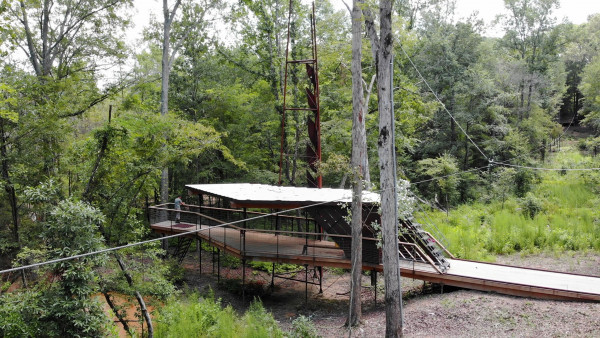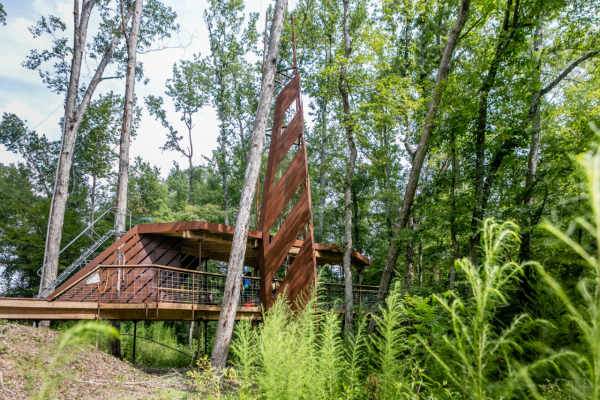MedCamps project takes flight

Submitted photos
A project for Louisiana Tech University’s School of Design’s ARCH 335 class won a Members Choice Award at the American Institute of Architects LA Design Conference Banquet last week in Baton Rouge. The zip line provides riders an elevated perch overlooking a stream where they can observe a multitude of flora and fauna.

The 712-foot zip line and support structures are at Camp Alabama in Choudrant was designed to encourage children with special needs to embrace the experience of flight.
Sometimes the most unlikely venture can take flight in a most unexpected and thrilling way.
And that’s what happened last week for students and professors from Louisiana Tech University’s School of Design’s ARCH 335 class as a project they created was honored Thursday at the American Institute of Architects LA Design Conference Banquet in Baton Rouge.
A project to design and build a special needs-oriented zip line launch and landing structures, including a “tree house” and climbing tower, won a Members Choice Award from the AIA Louisiana chapter for its 2019 Design Competition.
Tech’s ARCH 335 Design Build class, along with professors Robert Brooks and Brad Deal, designed the project.
Architects attending the Design Conference voted on The Members’ Choice Award, which two projects — the Tech project tied for the honor along wit the Betty Edward Marcus Sculpture Park at Laguna Gloria in Austin, Texas, designed by Trahan Architects of New Orleans.
“A state-funded school doing work for pennies on the dollar is right up there competing with, and tying, a project that millions of dollars were spent on,” Brook said. “It’s an incredible honor. There were three categories of awards. They had a lower-tier Merit Award. Then a high-tier Honor Award. Those were chosen by a select jury of three architects from off somewhere else and didn’t really represent what I would call the pulse of the AIA.
“Then you had the Member’s Choice Award, which was voted on by all the AIA members who were at the conference. And to be chosen by the group, competing against a big-time, milliondollar project I feel speaks volumes about the quality of Tech’s architecture program.”
The 712-foot zip line and support structures at Camp Alabama in Choudrant were designed to encourage children with special needs to embrace the experience of flight. At the launch site, dramatic steel walls gesture skyward, both visually obscuring and revealing the zip line. The deck was designed to facilitate safe loading, and a pivoting swing-arm allows wheelchair-bound campers to be hoisted up, swiveled into position and then transferred onto the zip line.
Riders unload at the “tree house,” which extends horizontally as the land falls away. Campers then find themselves on an elevated perch overlooking a stream where they can observe a multitude of flora and fauna. A floor hatch provides access to the ground below, reinforcing the feeling of “tree house.” A 50-foot tall steel tower offers an accessible ropes course challenge, too.
Deal said the ARCH 335 class has partnered with MedCamps for seven years now and that in the past the focus has been on repairing and improving existing structures at Camp Alabama.
“This is our first original project there,” Deal said. “We talked about a tree house and then Caleb Seney, who runs MedCamps, started talking about a zip line to the tree house. At first we thought there was no way. But after doing our homework we started looking at some of the top zip line companies to see if they could help.”
And sometimes, things are meant to be.
“We found out one of the top companies was in Trinity, Texas. Then we found out the head of that company — Chris Carter of Adventure Experiences, Inc. — grew up in Farmerville and has a special needs daughter. So for all of those reasons, he was particularly attracting to helping with the project.”
The project was inspired by a parable in which two peregrine falcons are gifted to a king who admired the birds for their speed, power and grace. One of the falcons, however, simply would not fly. After many unsuccessful attempts by experts to remedy this, the king was visited by a peasant who claimed she could get the falcon to fly.
Upon seeing the second falcon high in the air, the king implored “How?!” The peasant responded, “Simply by cutting the branch the bird was resting on. Some souls,” she said, “need to be reminded they have wings.”
Deal said the parable and its meaning is a special part of the project.
“That kind of thing really doesn’t happen in architecture firms, but in these college classes, we always try to integrate some kind of conceptual direction to the design. If you can find a strong one, it can make the project much more meaningful. So the class was talking about it, and we talked about super heroes, flight, overcoming obstacles and birds. They got fixed on the peregrine falcon, which is the fastest animal in the world.
“And the parable seemed perfect because what this project was all about was encouraging the MedCamps kids to take flight and soar in whatever they want to in life. So those kids helped inspire the class and the project as a whole. That had already made the ARCH 335 class winners. Winning the Best in Choice Award from the AIA only makes it that much better.”

